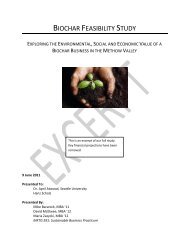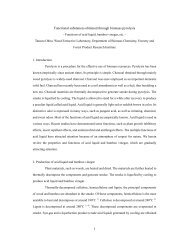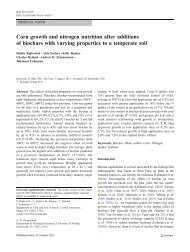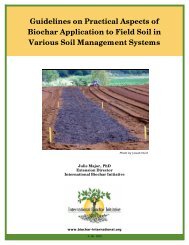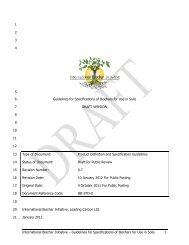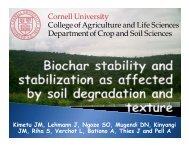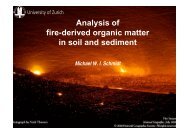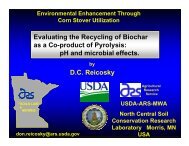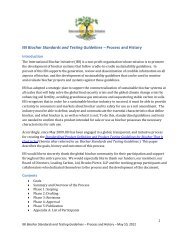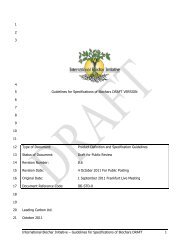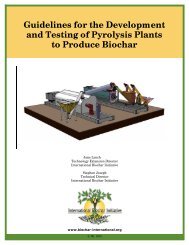Burn to air or burial in soil - International Biochar Initiative
Burn to air or burial in soil - International Biochar Initiative
Burn to air or burial in soil - International Biochar Initiative
You also want an ePaper? Increase the reach of your titles
YUMPU automatically turns print PDFs into web optimized ePapers that Google loves.
<strong>Burn</strong> <strong>to</strong> <strong>air</strong> <strong>or</strong> <strong>burial</strong> <strong>in</strong> <strong>soil</strong>: The fate of Ch<strong>in</strong>a’s straw residuesGenx<strong>in</strong>g Pan * , David Crowley , Johannes Lehmann §* Nanj<strong>in</strong>g Agricultural University, Nanj<strong>in</strong>g 210095-Ch<strong>in</strong>a; University of Calif<strong>or</strong>nia Riverside, CA92521, USA; § C<strong>or</strong>nell University, Ithaca, NY 14853, USAOne of the most imp<strong>or</strong>tant, but under utilized biomass resources <strong>in</strong> the w<strong>or</strong>ld <strong>to</strong>day is the largeamount of straw that is generated from the production of crop plants such as wheat, rape seed, andcot<strong>to</strong>n. Currently, most of this biomass is burned result<strong>in</strong>g <strong>in</strong> <strong>air</strong> pollution and loss of a potentialcarbon feeds<strong>to</strong>ck f<strong>or</strong> improv<strong>in</strong>g <strong>soil</strong> fertility. This problem is especially evident dur<strong>in</strong>g the monthsfrom May <strong>to</strong> June, when w<strong>in</strong>ter wheat and rape seed crops under double cropp<strong>in</strong>g with summer riceare harvested <strong>in</strong> southern Ch<strong>in</strong>a. <strong>Burn</strong><strong>in</strong>g straw residues <strong>in</strong> the field generates black carbonparticulates, giv<strong>in</strong>g rise <strong>to</strong> deteri<strong>or</strong>ated <strong>air</strong> quality <strong>in</strong> adjacent cities. In 2011, the <strong>air</strong> pollutioncaused by this practice was especially serious due <strong>to</strong> the severe “100-year” drought <strong>in</strong> southernCh<strong>in</strong>a. Follow<strong>in</strong>g severe levels of <strong>air</strong> pollution <strong>in</strong> May <strong>in</strong> Chengdu City, the capital of Sichuan, thelargest agricultural prov<strong>in</strong>ce of Southwest Ch<strong>in</strong>a 1 , the cities <strong>in</strong> metropolitan urban area of YangtzeValley Delta region all suffered extreme <strong>air</strong> pollution <strong>to</strong> the extent that it was rep<strong>or</strong>ted <strong>in</strong> the localmedia on the W<strong>or</strong>ld Day of Environment 2,3,4 , led <strong>to</strong> cancellation of many <strong>air</strong>plane flights andcaused breath<strong>in</strong>g problems f<strong>or</strong> the urban populations 5,6 .Due <strong>to</strong> these problems, straw burn<strong>in</strong>g <strong>in</strong> the field has been banned by the adm<strong>in</strong>istration ofCh<strong>in</strong>a’s government. Nonetheless, combustion of straw has not yet s<strong>to</strong>pped by the farmers. Even <strong>in</strong>Hefei, the capital of Anhui <strong>in</strong> the lower reach of Yangtze Valley, a first ticket f<strong>or</strong> burn<strong>in</strong>g wheatstraw <strong>in</strong> violation of ban on burn<strong>in</strong>g was issued sh<strong>or</strong>tly after the wheat harvest <strong>in</strong> early June 7 . Suchextensive burn<strong>in</strong>g <strong>in</strong> obvious violation of the government regulations reveals a threat <strong>to</strong> Ch<strong>in</strong>a’sagricultural and environmental quality that is of equal concern <strong>to</strong> problems caused by non-po<strong>in</strong>tpollution from nutrient runoff and <strong>soil</strong> acidification 8 . This even raises high concerns by the <strong>to</strong>pleadership of the Ch<strong>in</strong>ese government party, which is now call<strong>in</strong>g f<strong>or</strong> “far m<strong>or</strong>e than a ban” 9 .Fig. 1 A, Rape seed crop strawburn<strong>in</strong>g <strong>in</strong> suburb of Chengdu,Sichuan, May, 2011; B, A farmerburned wheat straw on W<strong>or</strong>ldEnvironment Day, June 5, 2011).<strong>Burn</strong><strong>in</strong>g of crop straw is also a concern with respect <strong>to</strong> <strong>in</strong>creas<strong>in</strong>g greenhouse gas emissions <strong>in</strong>Ch<strong>in</strong>a. Globally, greenhouse gas emissions from the agricultural sec<strong>to</strong>r contribute 14%, whereasemissions from agricultural sources account f<strong>or</strong> 17% of Ch<strong>in</strong>a’s <strong>to</strong>tal emission as rep<strong>or</strong>ted <strong>in</strong> thefirst national Communication on Climate Change of the Peoples Republic of Ch<strong>in</strong>a <strong>in</strong> 2004. The<strong>to</strong>tal cultivated croplands under rice, wheat, maize and cot<strong>to</strong>n amounts <strong>to</strong> 155 Mha and a <strong>to</strong>talbiomass production amounts <strong>to</strong> 1300 Mt. In turn, the result<strong>in</strong>g straw wastes from these crops havebeen estimated <strong>to</strong> be 0.7 Pg dry mass <strong>in</strong> 2006. In Henan Prov<strong>in</strong>ce, the central pla<strong>in</strong> of n<strong>or</strong>th Ch<strong>in</strong>a,approximately 25% of the straw material is burned <strong>to</strong> prepare the fields f<strong>or</strong> the next crop 10 . In otherareas the problem is w<strong>or</strong>se, such as <strong>in</strong> Jiangsu Prov<strong>in</strong>ce, where straw burn<strong>in</strong>g has <strong>in</strong>creased from21% <strong>in</strong> mid-1990’s <strong>to</strong> 48% <strong>in</strong> mid-2000s 11 .An overall annual CO 2 emission from straw burn<strong>in</strong>g <strong>in</strong>the field could amount <strong>to</strong> as much as 0.2 Pg, c<strong>or</strong>respond<strong>in</strong>g <strong>to</strong> 15% of the <strong>to</strong>tal CO 2 emissions
generated from energy production <strong>in</strong> Ch<strong>in</strong>a. Theref<strong>or</strong>e, proper disposal of straw is an urgentconcern not only f<strong>or</strong> control of <strong>air</strong> pollution and improvement of environment quality of humanbe<strong>in</strong>g, but also f<strong>or</strong> reduc<strong>in</strong>g GHG emissions from Ch<strong>in</strong>a’s fast develop<strong>in</strong>g economy.In western countries, biochar production via pyrolysis of agro-biowastes and return <strong>to</strong> field isbe<strong>in</strong>g pursued as a New Green Agriculture technology 12,13 , which is promoted globally by the<strong>International</strong> <strong>Biochar</strong> <strong>Initiative</strong>. This environmental-friendly and susta<strong>in</strong>able agriculturaltechnology also deserves pri<strong>or</strong>ity f<strong>or</strong> Ch<strong>in</strong>a, who has committed <strong>to</strong> reduce the CO 2 <strong>in</strong>tensity by40-45% by 2020 as compared <strong>to</strong> 2005. As an option f<strong>or</strong> meet<strong>in</strong>g this requirement, a state project ofGreen Energy County Demonstration was launched <strong>in</strong> 2010 jo<strong>in</strong>tly by the State Bureau of Energy,State M<strong>in</strong>istry of F<strong>in</strong>ance, M<strong>in</strong>istry of Agriculture of Ch<strong>in</strong>a 14 . This project is be<strong>in</strong>g perf<strong>or</strong>med <strong>in</strong>108 counties, with which the gasification, f<strong>or</strong>mulated combustion material and marsh gas fromcrop straw is be<strong>in</strong>g encouraged through state <strong>in</strong>centives 15 . However, recycl<strong>in</strong>g of crop straw is stilla challenge with respect <strong>to</strong> develop<strong>in</strong>g efficient mechanisms f<strong>or</strong> return <strong>to</strong> <strong>soil</strong>.Soil <strong>or</strong>ganic carbon(SOC) sequestration makes an imp<strong>or</strong>tant contribution f<strong>or</strong> mitigat<strong>in</strong>g climatechange 16 and the sequestration capacity of Ch<strong>in</strong>a’s croplands may be as high as 2-3 Pg C 17 . Bycomparison, the mean SOC s<strong>to</strong>rage of Ch<strong>in</strong>a croplands is estimated <strong>to</strong> be 1/3 lower than that of USand European agricultural <strong>soil</strong>s 18 . The huge capacity f<strong>or</strong> SOC sequestration <strong>in</strong> Ch<strong>in</strong>a could be fedlargely by crop straw <strong>in</strong>put. However, this will requiredevelopment of new <strong>in</strong>frastructure as landfragmentation and non-bus<strong>in</strong>ess management of cropproduction by subsistence farmers dim<strong>in</strong>ishes the<strong>in</strong>centive <strong>to</strong> recycle straw <strong>in</strong> the field 10 . This problemposes a great challenge f<strong>or</strong> meet<strong>in</strong>g the goal ofreduc<strong>in</strong>g GHGs reduction ambition while develop<strong>in</strong>gthe real capacity of agricultural production of Ch<strong>in</strong>a 19 .Nevertheless, great eff<strong>or</strong>ts by Ch<strong>in</strong>ese scientists andeng<strong>in</strong>eers have never s<strong>to</strong>pped <strong>in</strong> establish<strong>in</strong>g a practicalsolution f<strong>or</strong> recycl<strong>in</strong>g the crop straw <strong>in</strong> fields. Theseeff<strong>or</strong>ts have been targeted <strong>to</strong> a properly <strong>or</strong>ganized collection of crop straw <strong>in</strong> fields and biomasspyrolysis <strong>to</strong> produce biochar f<strong>or</strong> return <strong>to</strong> fields. After several year trials, a consecutive pyrolysiskiln (Fig. 3A and B) <strong>to</strong> convert straw biomass <strong>in</strong><strong>to</strong> syngas and biochar as well as pyrol<strong>in</strong>eticalsolution was f<strong>or</strong>mulated <strong>in</strong> 2010 <strong>in</strong> Henan Prov<strong>in</strong>ce 20 , which has been the largest producer of cerealgra<strong>in</strong> <strong>in</strong> Ch<strong>in</strong>a over the last decade. With this technology, 800 cubic meters of syngas and 350 kg ofbiochar can be obta<strong>in</strong>ed with pyrolysis of one <strong>to</strong>n of wheat straw without external energyconsumption. The collection <strong>in</strong> field and proper s<strong>to</strong>rage of large amounts of straw f<strong>or</strong> such apyrolysis plant, further required a mechanism f<strong>or</strong> local farmers <strong>to</strong> purchase these products and as<strong>to</strong>rage facility that rents strapp<strong>in</strong>g mach<strong>in</strong>es f<strong>or</strong> the straw bales. By this mechanism, the collectionof straw from fields is allowed with economical compensation <strong>to</strong> land owners and the s<strong>to</strong>ragekeeper sells the compacted straw <strong>to</strong> the company, which makes a bus<strong>in</strong>ess f<strong>or</strong> local farmers. Ofcourse, such a mechanism will not w<strong>or</strong>k efficiently with the very fragmented croplands, especially<strong>in</strong> po<strong>or</strong> regions such as <strong>in</strong> the loess hills and plateau region. Thus a small scaled pyrolysis systemus<strong>in</strong>g a simplified vertical kiln also was developed <strong>in</strong> Sanli New Energy Company, Henan (Fig. 3C),which allows an <strong>in</strong>-situ biochar and syngas production from straws collected <strong>in</strong> the vic<strong>in</strong>ity and thatfurther supplies gas f<strong>or</strong> cook<strong>in</strong>g and household use, while the biochar produced can be returnedSOM of croplands(%)5 65% of croplandsArea ofUS & EUcerealscroplands4(MoA,2004)production32102-3%
directly <strong>to</strong> local fields. With the small pyrolysis system, farmers can exchange straw harvested fromtheir own fields f<strong>or</strong> gas energy l<strong>in</strong>ked <strong>to</strong> their house. F<strong>or</strong> the very fragmented and SOC po<strong>or</strong>croplands such as <strong>in</strong> Shanxi Prov<strong>in</strong>ce, a group of farmer eng<strong>in</strong>eers developed a mobile pyrolysissystem which can be driven by a trac<strong>to</strong>r <strong>to</strong> the cropland and convert biomass <strong>in</strong><strong>to</strong> only biochar f<strong>or</strong>directly return <strong>to</strong> the fields(Fig. 3D). This pyrolysis mach<strong>in</strong>e can treat without exotic energy whea<strong>to</strong>r maize straw 400-500kg and produce 120-150kg of biochar per hour, which is almost the cropstraw produced <strong>in</strong> one mu(1/15 ha). Meanwhile, some agronomists from N<strong>or</strong>theast Ch<strong>in</strong>a haverecently <strong>in</strong>novated a small scale fixed pyrolysis kiln f<strong>or</strong> farmer use <strong>in</strong> their field when theyharvest<strong>in</strong>g the maize (Fig 3D). In this way, <strong>in</strong> situ carbonization of maize straw with pyrolysis isachieved <strong>in</strong> convenience of farmers and without much time consum<strong>in</strong>g. These mobile <strong>or</strong> fixedsmall scale systems may offer the farmers an opp<strong>or</strong>tunity <strong>to</strong> burn the straw as biochar f<strong>or</strong> <strong>burial</strong> <strong>in</strong>their <strong>soil</strong> <strong>in</strong>stead of burn<strong>in</strong>g <strong>to</strong> <strong>air</strong>, which is expected <strong>to</strong> encourage under the government <strong>in</strong>centives.Fig. 3 A, vertical kilns of large scale pyrolysis systemB, a small scale pyrolysis systemf<strong>or</strong> use <strong>in</strong> village; C, amobile pyrolysis system and D, a fixed <strong>in</strong> situ pyrolysis kiln.The potential role of biochar f<strong>or</strong> enhanc<strong>in</strong>g <strong>soil</strong> productivity and improv<strong>in</strong>g <strong>soil</strong> environmentalquality has been received much attention from Ch<strong>in</strong>ese agronomists and <strong>soil</strong> scientists. A group of<strong>soil</strong> scientist and agrochemists from the Institute of Resource, Ecosystem and Environment ofAgriculture, Nanj<strong>in</strong>g Agricultural University (IREEA-NAU) have been conduct<strong>in</strong>g fieldexperiments on biochar’s effect on <strong>soil</strong> reclamation and mitigation of greenhouse gases emissionfrom croplands f<strong>or</strong> a number of years. In the first rep<strong>or</strong>t of Ch<strong>in</strong>ese biochar field study, theircross-site field study across Ch<strong>in</strong>a’s ma<strong>in</strong>land have demonstrated consistently large effects ofbiochar amendments on reduc<strong>in</strong>g N 2 O both from dry croplands and rice paddies 21 . Thus theyrecommend the return application of biochar converted from crop straw as a maj<strong>or</strong> option <strong>to</strong> reduceN 2 O emission <strong>in</strong> fields f<strong>or</strong> Ch<strong>in</strong>a’s crop production 22 . Recently, another field study from this grouphas shown a surpris<strong>in</strong>g effect on reduc<strong>in</strong>g <strong>to</strong>xic heavy metals uptake and accumulation <strong>in</strong> cerealsgra<strong>in</strong>s <strong>in</strong> polluted fields 23 . They believe that biochar amendment will br<strong>in</strong>g a bright prospect f<strong>or</strong>ameli<strong>or</strong>at<strong>in</strong>g Cd-polluted rice field f<strong>or</strong> safer rice production <strong>in</strong> southern Ch<strong>in</strong>a rice areas, where Cdpollution is becom<strong>in</strong>g <strong>in</strong>creas<strong>in</strong>gly extensive and excessive Cd <strong>in</strong> rice becomes a public concerns 24 .M<strong>or</strong>eover, <strong>in</strong> a new field study completed <strong>in</strong> June 2011, Pan’s group has succeeded <strong>in</strong> develop<strong>in</strong>gan effective measure <strong>to</strong> ameli<strong>or</strong>ate salt affected <strong>soil</strong> and <strong>to</strong> ensure n<strong>or</strong>mal wheat growth <strong>in</strong> the areaof ancient valley of Yellow River, <strong>in</strong> Henan Prov<strong>in</strong>ce. They employed a coupled amendment ofbiochar with the acid pyrogenous solution from biomass pyrolysis and obta<strong>in</strong>ed a n<strong>or</strong>mal wheatyield of 6.7t/ha <strong>in</strong> a <strong>soil</strong> with salt content 0.5% and pH over 10 compared <strong>to</strong> only 0.6t/ha <strong>in</strong>un-ameli<strong>or</strong>ated salt land and 4.3t/ha with n<strong>or</strong>mal reclamation measures of <strong>or</strong>ganic fertilizationoperated by farmers [Fig. 4D]. A patent is be<strong>in</strong>g issued of such a technology f<strong>or</strong> fast reclaim<strong>in</strong>g theextensive salt affected <strong>soil</strong>s and a field demonstration of such amendment f<strong>or</strong> large scaleameli<strong>or</strong>ation of sal<strong>in</strong>e <strong>soil</strong>s is be<strong>in</strong>g operated <strong>in</strong> the costal lands of Jiangsu [Fig. 5], where a largearea of new lands are emerg<strong>in</strong>g due <strong>to</strong> mar<strong>in</strong>e deposition of sediments. Acc<strong>or</strong>d<strong>in</strong>g <strong>to</strong> their f<strong>in</strong>d<strong>in</strong>gsof beneficial effects of biochar amendments <strong>in</strong> croplands, they have f<strong>or</strong>mulated some biochar
products f<strong>or</strong> commercial use <strong>in</strong> the agricultural sec<strong>to</strong>r, such as biochar based comb<strong>in</strong>ed fertilizers,foliar growth promoters, and green growth media f<strong>or</strong> nursery plants and flowers. A number ofpatents of such products are be<strong>in</strong>g issued.As a brilliant prospect f<strong>or</strong> the <strong>in</strong>dustrialization of pyrolysis f<strong>or</strong> convert<strong>in</strong>g agricultural waste<strong>in</strong><strong>to</strong> biochar and associated products, biomass companies, agronomists and pyrolysis eng<strong>in</strong>eersSoil available Cd mg kg-17654321aaabbbwheat seasonrice seasoncbbCd(mg/kg)14121086420C0 C1 C2 C30C0 C1 C2 C30.80.6EF(%)0.4No biochar0.2<strong>Biochar</strong>0.00 20 40<strong>Biochar</strong> amendment rate(t/ha)Fig. 4. A, <strong>Biochar</strong> effects on reduc<strong>in</strong>g Cd mobility <strong>in</strong> <strong>soil</strong>B,<strong>Biochar</strong> effects on reduc<strong>in</strong>g Cd accumulation<strong>in</strong>rice and wheat gra<strong>in</strong>s; C, <strong>Biochar</strong> effects on depress<strong>in</strong>g EF ratio of chemical N fertilizers and D, wheatgrowth <strong>in</strong> biochar and pyrogenous solution ameli<strong>or</strong>ated salt affected <strong>soil</strong>.Fig. 5. A large scale demonstration of biocharamendment-aid reclamation of sal<strong>in</strong>e <strong>soil</strong>s <strong>in</strong>costal lands of Jiangsu.have agreed <strong>to</strong> establish a partnership f<strong>or</strong> further extend<strong>in</strong>g the production and application ofbiochar as a new green agriculture technology. Follow<strong>in</strong>g a concise policy brief<strong>in</strong>g <strong>to</strong> the centralgovernment last year 25 , a well documented recommendation of develop<strong>in</strong>g biochar enterprises <strong>in</strong>Ch<strong>in</strong>a is be<strong>in</strong>g transferred <strong>to</strong> the Ch<strong>in</strong>ese auth<strong>or</strong>ity. F<strong>or</strong> <strong>in</strong>f<strong>or</strong>mation exchange and expertise shar<strong>in</strong>g,an <strong>in</strong>ternational w<strong>or</strong>kshop will be hold <strong>in</strong> Nanj<strong>in</strong>g, hosted by the Institute of Resource, Ecosystemand Environment of Agriculture (IREEA, NAU) <strong>in</strong> September, 2011 when the Ch<strong>in</strong>ese partnershipof biochar will be launched. In the near future, biochar production of crop straw can be expected <strong>to</strong>extend over Ch<strong>in</strong>a, with which straw burn<strong>in</strong>g <strong>in</strong> field would be greatly avoided f<strong>or</strong> a better and
green agriculture.Fig. 6 <strong>Biochar</strong> associated agro-products <strong>in</strong>novated <strong>in</strong> IREEA, NAU. A, biochar based fertilizer and the liquid foliargrowth promoter; B, biochar heavy metal stabilizer; C, <strong>Biochar</strong> biofert)Refs cited:1. http://news.w<strong>or</strong>kercn.cn/rollnews/c2/2011/0519/319607154.shtml.2. http://zjnews.zjol.com.cn/05zjnews/system/2011/06/01/017564902.shtml3. http://news.qq.com/a/20110604/000377.htm.4. http://ah.anhu<strong>in</strong>ews.com/system/2011/06/04/004111373.shtml.5. http://news.ifeng.com/ma<strong>in</strong>land/detail_2011_06/04/6826041_0.shtml.6. http://ah.anhu<strong>in</strong>ews.com/system/2011/06/04/004111373.shtml.7. http://news.hefei.cc/2011/0603/020038249.shtml.8. Ju, X. T., X<strong>in</strong>g, G.X., Chen, X.P. et al., 2009. Reduc<strong>in</strong>g environmental risk by improv<strong>in</strong>g Nmanagement <strong>in</strong> <strong>in</strong>tensive Ch<strong>in</strong>ese agricultural systems. PNAS 2009, 106 (9), 3041-3046.9. http://cpc.people.com.cn/GB/64093/64099/12931299.html.10. Ma, J. Cause of straw burn<strong>in</strong>g <strong>in</strong> field by Ch<strong>in</strong>a’s farmers: A analysis of cost-benefit and policybarriers. Journal of Agrotechnical Economics, 2009, no2, 77:84. (<strong>in</strong> Ch<strong>in</strong>ese)11. Liu, L. H. Greenhouse gases emissions from agricultural residues burn<strong>in</strong>g” A case study ofJiangsu prov<strong>in</strong>ce, Ch<strong>in</strong>a. MS thesis, Graduate School, Nanj<strong>in</strong>g Agricultural University, 2011.12. Lehmann J. A handful of carbon. Nature, 2007, 447: 143-144.13. Tayl<strong>or</strong>, B.2010. The <strong>Biochar</strong> Revolution: Transf<strong>or</strong>m<strong>in</strong>g Agriculture & Environment. GlobalPublish<strong>in</strong>g Group, USA.14. http://www.newenergy.<strong>or</strong>g.cn/Html/0114/4281139956_2.html.15. http://www.sdpc.gov.cn/zcfb/zcfbtz/2010tz/t20101119_381246.htm.16. Smith P, Mart<strong>in</strong>o D, Cai Z C et al. Greenhouse gas mitigation <strong>in</strong> agriculture [J]. PhilosophicalTransactions of the Royal Society B., 2008, 363: 789-813.17. Lal, R., 2004. Offsett<strong>in</strong>g Ch<strong>in</strong>a’s CO 2 emissions by <strong>soil</strong> carbon sequestration. Climatic Change65, 263–275.18. Pan, G. 2009. S<strong>to</strong>ck, Dynamics of Soil Organic Carbon of Ch<strong>in</strong>a and the Role <strong>in</strong> ClimateChange Mitigation, Adv. Clim. Change Res., 2009, 5 (Suppl.): 11-18.19. Zheng, J. F., Pan, G., Cheng, K., et al., 2011. Perspectives on study on <strong>soil</strong> carbon s<strong>to</strong>ck andcarbon sequestration potential of Ch<strong>in</strong>a. Ch<strong>in</strong>ese Science Bullet<strong>in</strong>, <strong>in</strong> press.20. http://sanlix<strong>in</strong>nengyuan.com/news.asp?NewsId=390&class=2.21. Zhang, A.F. Cui, L.Q, Pan, G. et al., 2010. Effect of biochar amendment on yield and methaneand nitrous oxide emissions from a rice paddy from Tai Lake pla<strong>in</strong>, Ch<strong>in</strong>a. AgricultureEcosystems and Environment 139, 469-475.22. Liu, X.Y., Qu, J.J., Pan G., et al., 2010. Emission <strong>in</strong>tensity of N 2 O from chemical N fertilizer <strong>in</strong>
Ch<strong>in</strong>a’s rice production can be greatly reduced under biochar amendment: a cross site fieldexperiment. Climate Change, under review.23. Cui, L.Q., Zhang, A.F., Pan, G. et al., <strong>Biochar</strong> greatly reduces rice Cd uptake <strong>in</strong> a contam<strong>in</strong>atedpaddy <strong>soil</strong>: a two-year field experiment. Bio-resources, 6(3), 2605-2618.24. New food scare: some cadmium with your rice?http://blogs.wsj.com/ch<strong>in</strong>arealtime/2011/02/16/new-food-scare-some-cadmium-with-your-rice25. Pan, G., L<strong>in</strong>, Z.H., Li, L.Q. et al. 2011. Perspective on biomass carbon Industrialization of<strong>or</strong>ganic waste from agriculture and rural areas <strong>in</strong> Ch<strong>in</strong>a. J. Agric. Sci. Technol., 13(1): 75-82.



